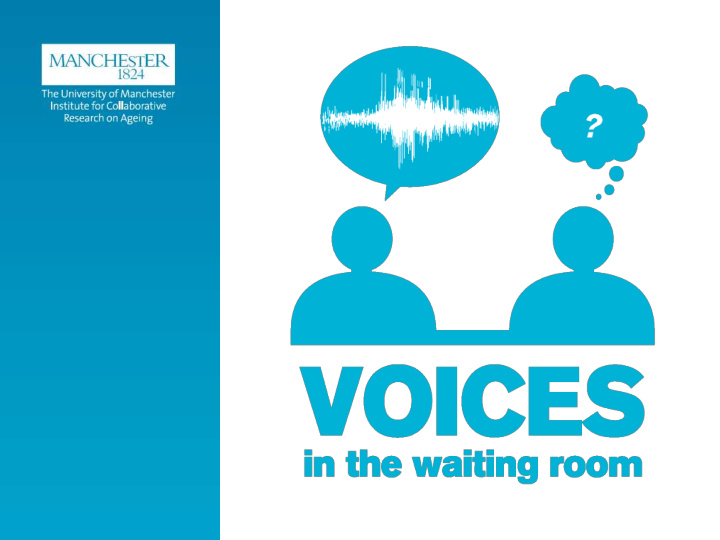



University of Manchester: • Dr Ian Brown, School of Nursing; • Dr Susan Rutherford, Department of Music; • Dr Tim Wilding, Audiology & Deafness Research; • Dr Jo Hart, Manchester Medical School. University of Salford: • Dr Bill Davies, Acoustics Research Centre.
Voice and Information • Content — information conveyed through linguistic means; • Paralinguistic or ‘communicative musicality’ features, comprising pitch, tone, rhythm, volume — information about speaker’s intentions, mood, identity, personality; • Inter-relationship between verbal content and paralinguistic features.
Voice quality Qualities associated with ‘vocal attractiveness’ and thus enhancing speech intelligibility and listener’s reception: • ‘good articulation, low shrillness, low nasality, moderate pitch and pitch range, and good resonance’ Jody Kreiman and Diana Sidtis , ‘Perception of Emotion and Personality from Voice’, Foundations of Voice Studies: An Interdisciplinary Approach to Voice Production and Perception (Wiley-Blackwell, 2011), 348.
Literature review: Four distinct vocal styles ….? • Conversational • Lombard • ‘ Elderspeak ’ • Clear speech
Conversational Typical where speaker believes listener hears well and is familiar with voice and no noise: • Faster pace • Narrower pitch range (or fundamental frequencies [F0]) • R educed formant (acoustic resonance or ‘spectral peaks’) • More unreleased consonant bursts (plosions) • Lower temporal modulation (rhythmic variation) • Reduced vowel space
Lombard (1909) Instinctive response to noisy environments: • Reduced speaking pace • Increased pitch and volume • Formant shifts to create more resonance • Lengthening of vowels • Vowel to consonant energy redistribution • Increased vocal effort • Increased facial expressivity Martin Cooke & Maria Lecumberri , ‘The Intelligibility of Lombard Speech for Non -Native Listeners’, Journal of the Acoustical Society of America, 132 (2012), 2: 1120-1129
‘ Elderspeak ’ An intergenerational communication style common (?) in some healthcare settings: • Simplistic vocabulary and grammar, shortened sentences • Slowed speech • Exaggerated intonation • Elevated pitch and volume • Greater repetition • Inappropriate terms of endearment • Overly directive or overbearing talk Kristine N. Williams, ‘ Elderspeak in Institutional Care for Older Adults’, in Communication in Elderly Care , ed. Peter Backhaus (Continuum, 2011), 1-19.
Examples
Clear speech Response where speaker believes listener has trouble with hearing and speech intelligibility: • Decreased speaking rate • Longer vowels and pauses • Expanded vowel space • Increased consonant energy and articulation • Increased energy at higher frequencies • Increased pitch and modulation Scarborough & Zellou , ‘Clarity in Communication: “Clear” Speech Authenticity and Lexical Neighborhood Density Effects in Speech Production and Perception’, Journal of the Acoustical Society of America, 134 (2013), 5: 3793-3807
Example of clear speech
‘Clear’ speech • Improves intelligibility by up to 26% for hearing-impaired listeners (Payton et al ) K.L. Payton et al , ‘Intelligibility of Conversational and Clear Speech in Noise and Reverberation for Listeners with Normal and Impaired Hearing’ , Journal of the Acoustical Society of America, 95 (1994), 3: 1581-92
‘What makes clear speech clear?’ • Insufficient data — small size of some studies (Caissie et al) • differences in responses between normal-hearing and hearing-impaired listeners; • ‘certain clear speech acoustic characteristics that enhance intelligibility for normal-hearing listeners may have no effect on or be detrimental to intelligibility for hearing- impaired listeners’ (Ferguson) Rachel Caissie et al , ‘Clear Speech for Adults with a Hearing Loss: Does Intervention with Communication Partners Make a Difference?’, Journal of the American Academy of Audiology , 16 (2005), 157-71. Sarah Ferguson, ‘Talker Differences in Clear and Conversational Speech: Vowel Intelligibility for Normal -hearing Listeners’, Journal of the Acoustical Society of America, 116 (2004), 4: 2365-2373
Developing Voice and Speech Habits • Recent studies on voice training for teachers demonstrated that although improvement could be achieved during sessions, it was rarely sustained in the months following training; • High drop-out rates from training sessions were also recorded in some studies. Pizolato et al , ‘Evaluation of the Effectiveness of a Program of Voice Training for Teachers’, Journal of Voice , 27 (2013), 5: 603-10.
Different approaches • Avelina Aquino, Speech and Oral Communication for Nursing (Quezon City: Rex Publishing, 2008)
Recommend
More recommend